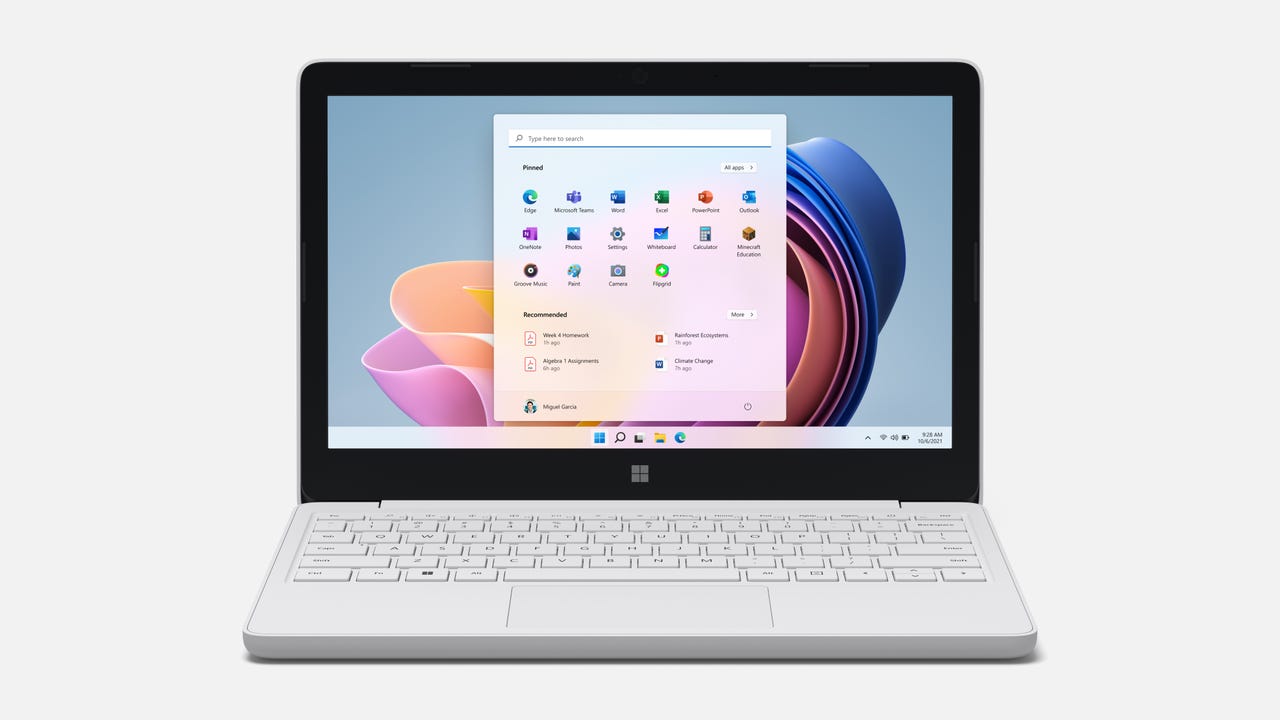
































Microsoft's new Surface Laptop SE running Windows 11 SE, both optimized for the education market.
Credit: MicrosoftMicrosoft is taking the wraps off a new Windows 11 SKU called Windows 11 SE, as well as a newSurface Laptop SE device today, November 9. The new Windows 11 edition is a simplified version of Microsoft's newest OS release, customized for the K-12 education market. The new Surface Laptop SE,which starts at$250 , is targeted at the same space.
Microsoft rolled out the Windows 11 SE release and device simultaneously with its virtual Reimagine: What's Next for Education event on November 8. The existence of both the Windows 11 SE SKU and the laptop were reported a couple of weeks ago by Windows Central.
See also: The best Surface PC: Every Surface device is Windows 11-ready.
Windows 11 SE (which I'd think stands for Student Edition or School Edition, but which Microsoft claims doesn't stand for anything in particular) will only be available preloaded on new devices for the education market. It won't be available for existing devices or made available separately for users to install on any other devices. It will be available pre-installed on PCs that are available via education purchasing channels. It won't be actively sold to business users or consumers. Schools can pave their Windows 11 SE devices and reinstall any legitimate Windows version for which they have a license, but once they do this, they cannot go back to Windows 11 SE, according to Microsoft.
Microsoft is positioning Windows 11 SE, which was codenamed "Hailey," as providing a simple, distraction-free environment for students and school admins. It will open apps full-screen, will not support widgets and only allow two choices of side-by-side snapped-app grids. As Microsoft is discontinuing its Microsoft Store for Education, Windows 11 SE won't include a built-in Store for apps, but it will enable admins and/or students to download a somewhat curated set of third-party apps, including Chrome and Zoom. Microsoft is touting Microsoft 365 for Education, which will enable students to have offline copies of the key Office apps and store their work locally in case they don't have Internet access outside school, is well-suited, though optional, for Windows 11 SE devices.
There is nothing new in the Windows 11 OS itself that is designed to make device provisioning, wiping and updating easier. Microsoft says admins should use existing Intune, Intune for Education and/or Windows Autopilot tools to deploy and manage Windows 11 SE devices. Of these, Intune for Education is a must; admins who want to use other non-Microsoft management tools should opt for an OS other than Windows 11 SE, Microsoft says.
Microsoft built Surface Laptop SE to be its own first-party device for the K-8 education market running Windows 11 SE. Various OEMs, including Acer, ASUS, Dell, Dynabook, Fujitsu, HP, Lenovo and other PC makers also will be rolling out their own Windows 11 SE PCs. Microsoft officials said they expect the majority of these devices to be available for ordering through education channels later this year and into 2022.
Surface Laptop SE, seemingly codenamed "Vivian," is a plastic-encased device with an 11.6-inch screen, front-facing 720-pixel camera and accessible screws on the bottom to make it easily repairable. Surface Laptop SE uses the same keyboard and trackpad as Surface Laptop Go. It Surface Laptop SE features an Intel Celeron processor (N4020 or 4120), 4 GB or 8GB of memory and 64GB or 128GB of eMMC storage. It has a USB-A and USB-C port, plus a barrel-type power connector. Microsoft is claiming 16 hours of "typical" usage battery life (which, based on my experience, will be 8 hours, at best). Unlike most recent Surface PCs, the Laptop SE has a 16:9 ratio, rather than 3:2 (maybe to save on the cost of components?).
Microsoft has pursued a variety of strategies as part of its Chromebook-compete efforts for the past several years. It introduced the Surface Go in 2018, with the EDU market as one of its primary audiences. Because the Go wasn't truly "low-cost," -- as it started at$400 without a keyboard or pen (both costing extra) -- it's not clear how much success it has had in that market. Microsoft also planned to try to win over the education market with its Windows 10X operating system, which it dropped before it ever came to market. Microsoft officials have said that many of 10X's planned features were included in Windows 11.
Update (November 9): Here are a few additional interesting tidbits from Microsoft's FAQ about Windows 11 SE.
The recently announced Microsoft 365 A1 per-device license does figure in with Windows 11 SE. That new$38-per-device license that is good for six years actually comes with Windows 11 SE, Teams, Office, OneNote and Class Notebook, plus other "education centered" apps like Minecraft: Education Edition, Flipgrid and Reading Progress. And this new license also includes Intune for Education.
Windows 11 SE is definitely not as restrictive as Windows 10 in S Mode is/was. However, the types of apps customers can install and run natively will be limited to six categories: Content-filtering apps, test-taking apps, accessibility apps, classroom communication apps, diagnostics/management/connectivity and supportability apps and browsers. Students won't be able to download things like games, YouTube, etc. on Windows 11 SE by design. It's supposed to be a platform for running a set of apps curated by school IT/admins.
Windows 11 SE won't be the only education-focused version of Windows 11, going forward. Microsoft will continue to offer Windows 11 Pro Education and Windows 11 Education. Microsoft considers Windows 11 SE a "cloud-first edition of Windows 11" that is more controlled by IT than Pro Education, which allows students and others to install apps on their own devices.
 Etiquetas calientes:
tecnología
Nuestro proceso
Servicios y Software
Sistemas operativos
La la de la la
Etiquetas calientes:
tecnología
Nuestro proceso
Servicios y Software
Sistemas operativos
La la de la la